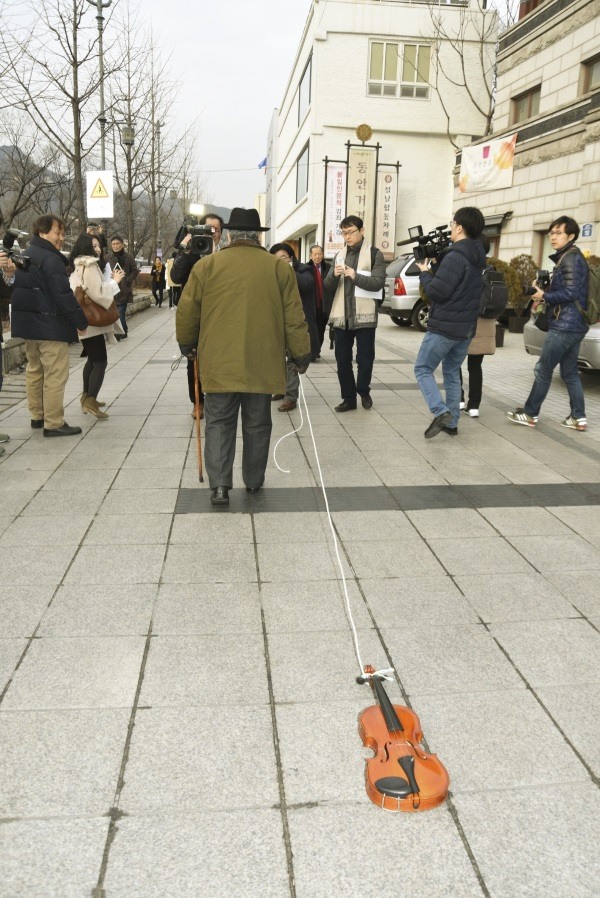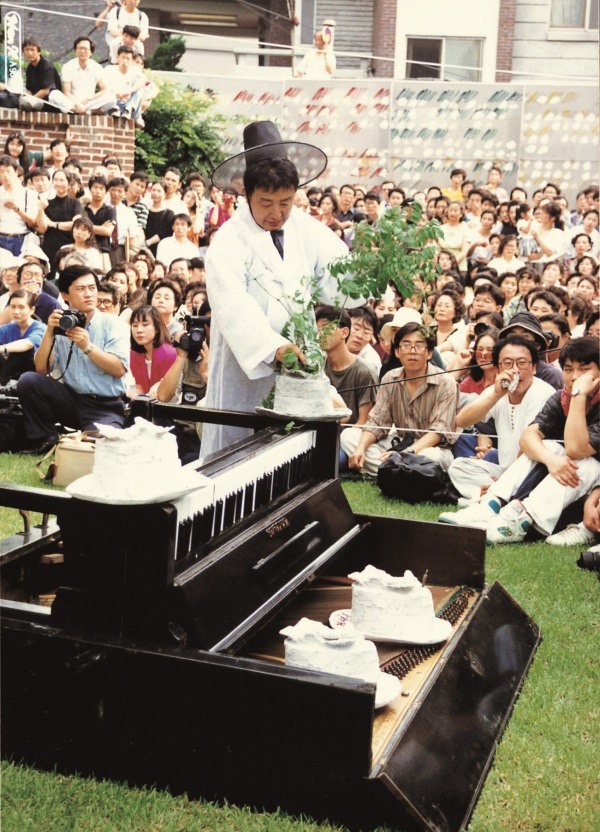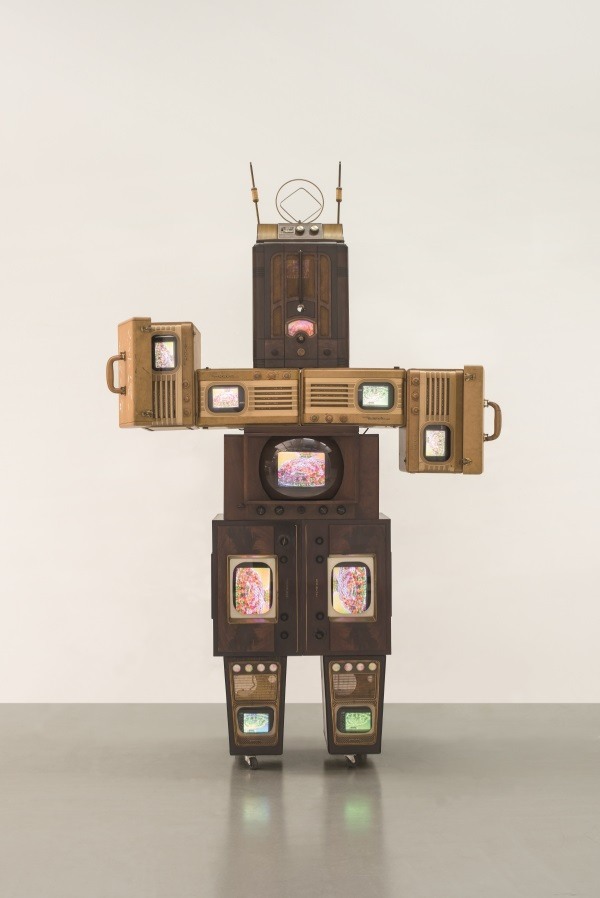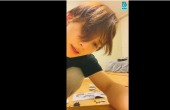Remembering ‘crazy Corean’ Nam June Paik
In 1963, Nam June Paik hung a blood-dripping cow head at the entrance of his first solo exhibition “Exposition of Music ? Electronic Television” in Germany, shocking those at the scene and the German art circle.
He continued to shock people with experimental and radical performances and said in several media interviews that he wanted to be remembered as a “crazy Corean.”
At the same show, Joseph Beuys gave a performance in which he destroyed a piano on display with an axe. The performance was similar to Paik’s performance the previous year in which he had smashed a violin after lifting it up deliberately and slowly for five minutes on a stage in Germany. Paik’s early radical performances earned him the moniker “terrorist from the East” among Westerners, who viewed breaking a violin into pieces as a challenge to the tradition of Western classical music.
Of his many performances, the one in which Paik broke a violin recurred frequently between the 1960s and 1980s.
On Jan. 28, Paik’s iconic violin performances were enacted by Korean artist Kim Tschang-yeul, known for his water drop paintings, one day ahead of the 10th anniversary of Paik’s passing. The performance also opened the Gallery Hyundai show “Nam June Paik: When He was in Seoul”, which pays tribute to Paik’s legacy.
 |
| Artist Kim Tschang-yeul (Gallery Hyundai) |
The 87-year-old artist walked with a cane to support himself while dragging a violin from one Gallery Hyundai building to the other, covering a distance of less than 100 meters, in Samcheong-dong. He entered the second Gallery Hyundai building, stopped in front of a white table, held up the violin and smashed it in one motion.
“Violins make delicate sounds. This is a resistance to the delicate sound,” said Kim.
“I thought Paik would have thought that way and that may be the reason he destroyed it.”
If Paik were still alive, he would be three years younger than him, said Kim. Kim met Paik in New York, along with artist Kim Whan-ki, who was working in New York at the time, and two gallerists from Korea, including then head of Gallery Hyundai Park Myung-ja, in 1983. She is now the gallery’s chairperson.
Another performance by one of Paik’s collaborators, Jean-Paul Fargier, captured the attention of many visitors at last week’s opening. Fargier, a French producer and researcher, had worked with Paik, filming some of his performances, including the 1990 shamanic ritual in Seoul that was held to commemorate German Fluxus artist Joseph Beuys, a long-time friend of Paik’s.
The 1990 performance was one that has been a long-time coming. Paik and Beuys had promised to do the performance together in time for the 1988 Seoul Olympics. They planned to merge their souls together, each representing Korea and Eurasia respectively, through a shamanic ritual. However, things did not go as planned as Beuys died two years before the Olympic Games. Paik realized this promise in 1990 in the backyard of the Gallery Hyundai with Korean shamans and with symbolic objects that represented different aspects of Beuys and himself ? a piano, two hats made of cement, television and candles, among other things.
 |
| Nam June Paik (Gallery Hyundai) |
On Thursday, Fargier brought with him the white robe and hat Paik had worn at the ritual that the late artist had performed. He lit a candle inside an empty TV screen and looked at the Korean shamanic altar that had piles of apples, pears and a steamed pig head.
He covered the broken piano with the robe and walked around the cement hat that resembled Beuys’ trademark fedora.
“I have seen many works of Nam June Paik, but this exhibition is very meaningful to me,” said Fargier, who met Paik in 1978 in France.
The commemorative exhibition displays Fargier’s 1990 film “Play It Again, Nam,” a video documentary biography of Paik, which shows his early works, artistic endeavors, as well as pictures of him as a child.
Gallery Hyundai’s exhibition marks the 10th anniversary of Paik’s death, but also sheds light on Paik’s works related to his home country Korea.
 |
“This exhibition is more than a commemorative show that marks his death, but a retrospective held so many years later in his home country, encompassing his lifetime works,” said Lee Yong-woo, director of Shanghai Himalayas Museum in Shanghai, in his essay for the exhibition.
Paik became known to Koreans through his 1984 satellite performance broadcast on the state-owned network broadcaster KBS on Jan.1. The transcontinental broadcast “Good Morning Mr. Orwell” that began with the phrase “George Orwell, you were half right” was intended to rebut George Orwell’s “1984” and highlight positive aspects of media use. He visited Korea for this project, his first visit in 34 years after he and his family moved to Japan in 1950.
Later, he made popular robot installation series inspired by Korean history and culture. He presented television installations such as “King Sejong” of Joseon Dynasty and “Queen Seondeok” of Silla Kingdom. Also on display at the Gallery Hyundai is part of the “Family of Robot” series depicting a grandfather, a grandmother and a grandson, recalling Paik’s childhood home in Seoul.
“Paik once compared video art to bibimbap. Video is a mix of aesthetic components and holds brave languages that represent democracy, resistance, aesthetic nondeterministic factors, anti-authoritarianism,” wrote Lee.
The exhibition runs until April 3 at Gallery Hyundai in 14 Samcheong-ro, Jongno-gu, Seoul. For more information, call (02) 2287-3500.
By Lee Woo-young (wylee@heraldcorp.com)




























